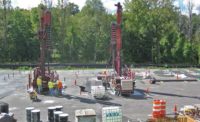After nearly 30 years as a federal Superfund site, a full cleanup of radioactive and contaminated soil at the former Hunters Point naval shipyard in San Francisco appears as far away as ever, with the U.S. Navy agreeing to retest all of a contractor’s soil samples from two parcels highlighted in a U.S. Environmental Protection Agency review.
The cleanup of the approximately 500-acre site, once used for warship repair and nuclear weapons research, has been plagued by environmental scandals. Over the years, former employees at Pasadena contractor Tetra Tech have claimed extensive soil data manipulation and falsification.
The EPA reviewed a September 2017 Navy draft report on Tetra Tech’s soil data from two parcels covering 40% of the shipyard. The agency recommended resampling 90% of soil samples from one parcel and 97% of samples from the other. The Navy had recommended resampling 15% of Tetra Tech’s samples from the first parcel and 49% of the second.
The draft report and the EPA review were released April 9 by advocacy group Public Employees for Environmental Responsibility through a Freedom of Information Act request.
“The data analyzed demonstrate a widespread pattern of practices that appear to show deliberate falsification, failure to perform the work in a manner required to ensure [Superfund cleanup] requirements were met, or both,” Superfund division manager John Chesnutt wrote the Navy in December.
Tetra Tech is aware of allegations made by former employees of a subcontractor, the company says in a statement, and “vehemently denies that such allegations are representative of Tetra Tech’s actions at the site. Tetra Tech holds itself and its subcontractors to the highest standards. At all times, our work was monitored and overseen by the Navy.”
The Navy sees “no fundamental disagreement” between Navy and EPA regulators regarding the cleanup data, says Derek Robinson, the Navy’s environmental coordinator for the cleanup in a statement. The Navy’s percentages for recommended soil resampling represented potential data falsification only, while the EPA’s resampling recommendations covered potential falsification and factors like quality control. The Navy and EPA both agree that all Tetra Tech radiological work areas need to be retested.
The EPA is reviewing testing at other parcels covering 60% of the site.
Former Tetra Tech employees reported manipulating and falsifying soil data in various ways, the Navy report says, including discarding samples that offered unwanted results, screening soil at speeds too high to properly detect radiation, and taking soil samples from less radioactive sites to pass off as samples from areas being investigated.
In a city desperate for housing, the Hunters Point shipyard site remains a much-coveted area for development, with new homes, retail and parks planned.





Post a comment to this article
Report Abusive Comment